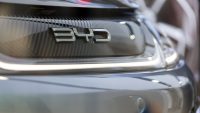 Ah, how different things were a decade ago. Back then everything was booming. Nothing was running out. Anything was possible. Well, almost.
Ah, how different things were a decade ago. Back then everything was booming. Nothing was running out. Anything was possible. Well, almost.
Certainly, launching the world’s fastest, most powerful, most expensive car was but a walk in the park. Well, it was if your surname was Piech, and you were boss of the mighty Volkswagen.
Ferdinand had already bought the famed Bugatti brand, and shown a deluge of hyper-extravagant concept cars, including an 18-cylinder monster. Now, his dream was to be realised on the road.
All due credit to the good Doctor: the production model was barely any less dramatic. A two-seat mid-engined luxury performance coupe, the car that would become the Veyron was initially known as the 16/4.
Why? Well, 16 cylinders, of course. Oh, and four camshafts, instead of eight – the ‘W’ design, and narrow angle, meant the cam count could be cut in half.
It was basically a Golf VR6 on hyperdrive. Well, almost. There was no quibbling with the figures Piech quoted – 987bhp, four turbos, more pulling power than some planets. Everything about the stat sheet was monstrous, from the 9mpg combined economy, to the 8,000cc capacity, to the fact it could top 200mph.
Nay, not just 200mph, either. This thing went on to top 250mph – 253mph, to be exact. And if you don’t believe them, check out James May’s run on Top Gear, easily found on many a YouTube search. All a bit undramatic, was Captain Slow’s remark, as he became one of the fastest car drivers in the world.
It was – and still IS – utterly, ridiculously insane. Don’t let the smooth styling and understated, chintzy air fool you. The Veyron is a blimmin’ warrior, albeit a fantastically easy one to handle courtesy of four-wheel drive, electric control of everything, and a DSG flappy-paddle gearbox just like in a Golf 1.4 TSI.
At low speed, it could be as docile as a Polo. It just so happens to transform into a rocket whenever you press the right pedal.
It stops, too. Brakes are massive. Yet not even discs the size of large dinner plates are enough to slow it – Bugatti also had to design a massive rear air brake, that explodes up in an eye-blink to help drag the thing to a halt. You think F1 cars are hi-tech? They look like kit cars compared to the amount of kit packed into this.
And, naturally, it corners. Ridiculous tyres are said to cost £5k a piece (yes, that’s each), and stick the thing to the tarmac like it’s MADE from tarmac. Providing an intense racecar experience, tails out and balls out, was not part of Bugatti’s remit with this. No, Piech wanted plain intensity, sheer force of incredulity. My how he achieved it.
When it came to market, he was right about something else, too. It really was the world’s most expensive car. Yours for about £800k sir – and that’s before options. Bugatti drivers could spend a lot more besides, by getting their consorts to tick an endless array of boxes.
You have to wonder why they’d ever need to. After all, they’re hardly jam-packing our roads, these things. Production has now switched to the open-top Grand Sport, meaning there are only around 200 Veyrons on the road. But, my goodness, how achingly special every one is.
The Golf that can do the impossible. Hard to think it would ever be made nowadays, but how great it is that Bugatti did help give the supercar a real millennial bang.
More Cult Cars can be found here
































